|
Fisher
Body - Home
Fisher Body Craftsmanship Goes to War
Fisher Body - Craftsmanship
Fisher Body - Aircraft
Fisher Body - Aircraft
Instruments
Fisher Body - Guns
Fisher Body - Tanks
Fisher Body - Miscellaneous
The Plants
Fisher Body WWII Plant Database
Cleveland Plant #1, OH Plant
Cleveland Plant #2, OH Plant
Detroit Aircraft Unit,
Detroit, MI
Detroit Die and Machine Plant
Fleetwood, Detroit, MI Plant
Flint Plant #1, MI Plant
Grand Blanc, MI Tank Arsenal
Grand Rapids, MI Plant
Lansing, MI Plant
Memphis, TN Plant
Ternstedt Manufacturing Division,
Detroit, MI
Grand Blanc Tank Arsenal Built Tanks and Tank Destroyers
Grand Blanc
built M4A2 Sherman Tank Photos
Grand Blanc
Built M4A3 Tank Photos
Grand
Blanc M10 Tank Destroyer Photos
Fisher Body Plant 21 - Detroit Aircraft Unit in World War Two
A Surviving Fisher
Body Plant
Detroit, MI
1919-Current
Fisher Body - Gone but not Forgotten!!!
This page added 2-25-2021.

This imposing six-story building was the former Fisher Body Plant 21, located at the corner
of Piquette and St. Antione Streets in Detroit, MI. During
World War Two, it was the Detroit Aircraft Unit.
It was built in 1919 by Albert Kahn for the Fisher Brothers, seven years
before they became part of General Motors. The plant closed in
1984. General Motors was apparently was able to sell the building
and then the new owners either moved out later or were not able to
maintain such a large building. Even though one million dollars have been spent on cleaning up the legacy
environmental contamination inside the plant, it is still on the EPA
contaminated list.
From an architectural standpoint, this plant is
an excellent example of the multi-story auto plants that dotted the
Detroit landscape in the early 20th century. Fisher Body Plant 21
is one of the most photographed buildings in Detroit, due to its
symbolism in representing what the American Automobile Industry was when
it dominated the world, contributing mightily to winning World War Two, and then its
fall from dominance when it focused on the short term bottom line
instead of taking care of its customers. Author's Photo.
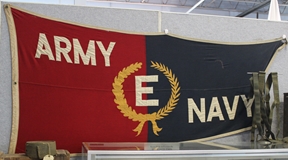
The Fisher Body Detroit Aircraft Unit won the Army-Navy "E" award
four times.
Fisher Body Detroit Aircraft Unit World War Two Products:
B-25, B-29, XP-75, P-80, and FG-4 aircraft parts and assemblies
B-29: The table below shows
that the proposed shipment schedule did not match up with the number of
B-29s built in each plant. Renton was scheduled to receive almost
three times the number of tail gun and rudder assemblies compared to the
number of the B-29s built. It is unknown from the historical
record whether the excess components were shipped to the other plants.
The Fisher Body Detroit Aircraft Unit made more than enough of the
assemblies to supply all of the B-29s built.
| Fisher Body
Detroit Aircraft Unit B-29 Components Shipment Schedule |
| |
Boeing-Renton, WA |
Boeing-Wichita, KS |
Bell-Marietta, GA |
Martin, NE |
Total |
|
Number of B-29s built |
998 |
1,595 |
652 |
515 |
3,760 |
| Tail gun assemblies |
2,700 |
601 |
200 |
400 |
3,901 |
| Rudder pedal assemblies |
2,700 |
|
900 |
750 |
4,350 |
The next three photos show the B-29 tail
gun assemblies being assembled at the Detroit Aviation Unit.



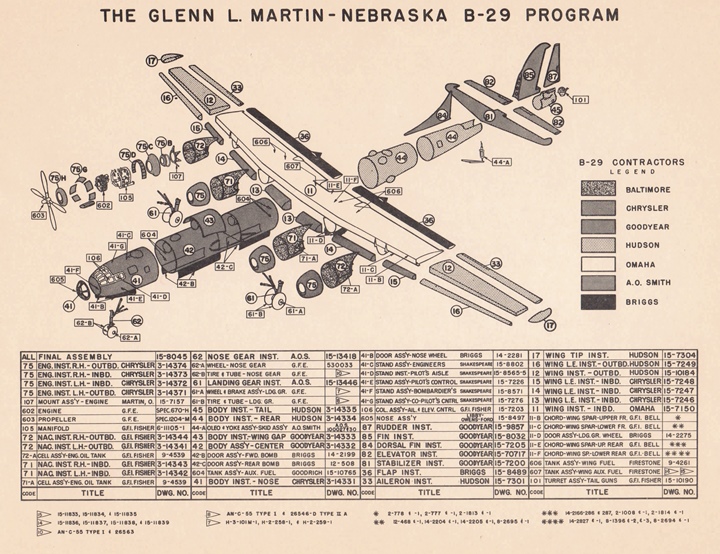
This shows the main contractors for the
B-29s built by Martin Omaha, NE. Part number 101, in the lower right
hand corner of the table, shows that the Turret Assembly-Tail Guns were
furnished by G.F.I Fisher. G.F.I. stands for Government Furnished
Items. The Army Air Force contracted directly with Fisher Body to
purchase the tail gun assemblies, and then had Fisher Body drop ship
them to the B-29 assembly plants per its instructions.
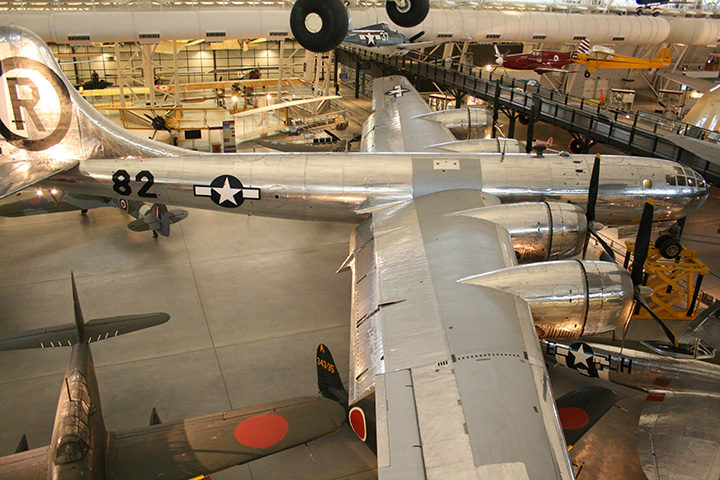
The B-29 Enola Gay was built at the Martin
plant in Omaha, Nebraska. Fisher-Body was shown as the supplier of the
tail gun turret assemblies.
Author's photo.

The next several photos show the Fisher
Body-built rear gun turret in the Enola Gay. All of the other gun
turrets were removed from the aircraft to decrease the weight of the
aircraft. The tail gun turret was considered important enough to
prevent an attack from behind, so it was left in the aircraft.
Author's photo.

Author's photo.

Author's photo.

Author's photo.
XP-75 and P-75A:
The Fisher Body Detroit Aircraft Unit
fabricated and assembled rudder pedals for the aircraft. It also
assembled fairings and cowlings fabricated at other Fisher Body plants.
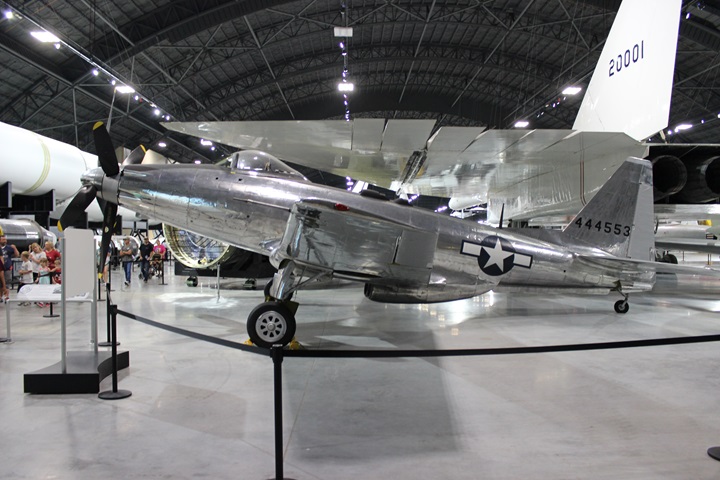
Only (8) XP-75s and (6) P-75s were built during World War Two. While
only fourteen total airframes were built, Lansing and other Fisher Body
plants were planning and producing for a high production run. Many more
than fourteen sets of components were built. This
is the only remaining P-75A Eagle of the fourteen aircraft that were
built. It is on display at the National Museum of the
United States Air Force.
Author's photo.
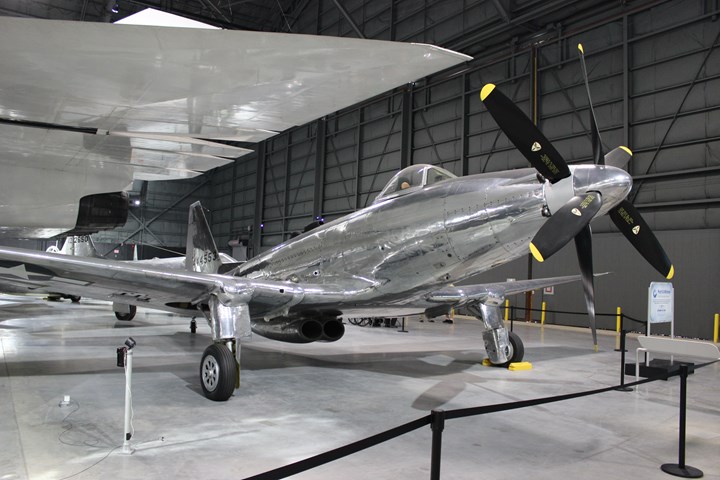
Author's photo.
What didn't happen: In the "Fisher
Body Craftsmanship goes to War" it notes that there was a
contract placed for Lockheed P-80 intakes and wingtips. There was
also a contract to build 1,500 FG-4 engine cowlings for Goodyear.
Both contracts were issued late in World War Two and neither was
completed. Very few parts, if any, were built or delivered due to
the sudden end of World War Two in August 1945.
Several historical sources
have misinterpreted this information and claim the Fisher Body Detroit
Aircraft Unit actually built P-80s and FG-4 complete aircraft. The contract
was for tooling and parts, not entire aircraft.

The FG-4
was to be the Goodyear-built version of the Vought F4U-4 Corsair.
It never went into production due to the sudden end of the war in August
1945. This is a Vought F4U-4 that was built after World War Two.
The Detroit Aircraft Unit would have built the engine cowl like the one
on this aircraft. Author's photo.

This is a Lockheed P-80. The Detroit
Aircraft Unit never had the opportunity to make parts for this type
aircraft due to the end of the war. Author's
photo.

The Detroit Aircraft Unit was contracted to
build tooling and to make the wingtips on the P-80. Author's
photo.

The Detroit Aircraft Unit was also going to
make tooling and build P-80 engine intakes. Author's photo.
|
















